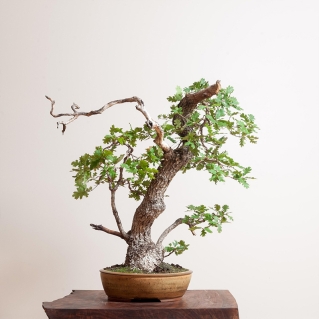Trident Maple Bonsai

General Information
Trident maple — Acer buergerianum — is one of the most vigorous temperate broadleaf deciduous species that exists in bonsai. The strength of these trees comes from the vascular system and you can heavily prune their roots and branches.
Some of the reasons trident maple bonsai are so popular:
- The ability to become very thick and fluid in their movements
- A flaking, creamy bark that creates interesting patterns
- Tight, tiny three-pointed leaves
The leaves give wonderful interest in the spring as they originate and turn incredible colors of yellow, orange, and red in the fall. As a bonsai subject, the trident maple creates four seasons of delight.
Trident maple lends itself to stone plantings well, as it grows with a particular root over stone composition that creates interesting relationships and patterns.
This strong and durable species is one of the traditional pillars of bonsai.

Caring for Trident Maple Bonsai
Watering
Because trident maple is a deciduous species, it can tolerate some dryness in the soil and the soil should never be sopping wet.
Every tree needs a balance of water and oxygen, and trident maple—like any broadleaf deciduous species—leans toward the water-heavy side, preferring to be moist and damp.
However, because trident maple can tolerate some dryness in the roots, you want it to dry slightly between waterings—but never become bone dry.
In general, trident maple bonsai should be watered regularly and keep a fairly consistent amount of water in the container for it to be successful. This is especially true for a vigorous or aged trident maple with an abundance of leaves.
Sun Exposure
Since trident maple is such a durable broadleaf deciduous species, it can tolerate the sun well and benefits from full sun in the spring and fall.
Trident maple bonsai continue to enjoy plentiful sun until temperatures hit 85-90℉. Once the full heat of summer is underway, they should be kept under a 30% shade cloth.
This typically allows trident maple bonsai to tolerate the sun’s intensity—unless the relative humidity gets too low. If the relative humidity drops below 10%, more shade is needed.
Temperature
Trident maple bonsai can tolerate temperatures well over 100℉ as long as they are properly shaded. See the next section for more information on how to shade your bonsai properly.
Trident maple bonsai winter care can be a bit trickier, as they do not tolerate heavy freezing. This is because their thick, fleshy tissue holds a lot of water, even over the winter season.
When there are dramatic freezes (temperatures consistently below 28℉) trident maple will show winter dieback not only in the branching and fine twigs, but also in areas of the trunk.
Fortunately, trident maple will tolerate temps down to 28℉ dependably without dieback.
Fertilizing
If you are developing your trident maple bonsai in the spring, you should be fertilizing aggressively. Trident maple can thicken rapidly with feeding, and this is a great way to:
● Develop it to heal big wounds
● Get thicker branches
● Grow the trunk
You should do the same thing if you are developing in the fall.
However, if you are refining your trident maple, you want to hold off on spring fertilization so the tree can use its stored energy. If you give fertilizer during this time, you’ll end up with excessively long internodes .
When you do post-flush harden partial defoliation and pruning, you should give your trident maple bonsai a light application of fertilizer.
Hold back on fertilizer in the heat of summer, then train refinement by giving it light fertilizer at the beginning of fall.
Trident Maple Bonsai FAQS
No, trident maple bonsai is an outdoor plant, as it does best in sunny spots for most of the year.
If you really want an indoor maple bonsai, it is possible—but probably more trouble than it’s worth. For instance, the Japanese maple can survive indoors, but it still needs to be taken outside for part of each day during the growing season.
Trident maple is brittle, but it can be bent. It is most flexible as the leaves drop in the fall, so this is the best time to get big moves and bends out of it. It can also patch and heal well during this time.
In general, trident maple bonsai should have a slight rotation of the tissue to make it more bendable. You should never twist it. The slight rotation makes it slightly more flexible and distributes the force of the bend over a wider amount of tissue.
To really get a trident maple bonsai to bend, you should wire new growth as it hardens—while it’s still green, but before it turns woody





